TO THE LIMITS OF THE SOUL'S
IDEAL:
GETTYSBURG
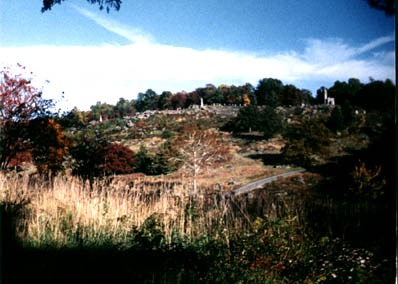
Little Round Top,
Gettysburg National Military
Park, Gettysburg, PA.
This was taken from the rocks at
Devil's Den; the 20th Maine's position was to the right and behind
the trees, on the side of the hill facing nearby Big Round Top. . The
rest of the Fifth Corps' Third Brigade--83rd Pennsylvania, 44th New
York, and 16th Michigan--filed into line on their
right.
From Chancellorsville, the 20th Maine, and the rest of the AOP,
began their pursuit of Lee's army in late May 1863. During that long
march in the blazing sun, Chamberlain came down with sunstroke, and
was briefly left behind to recover. Without him, the 20th fought at
Middleburg, VA, under the temporary command of the 44th New York's
Lt. Colonel Freeman Conner. Chamberlain was aided in his recovery by
his younger brother John, who had joined the Christian Commission,
and managed to find both the regiment, and his brothers Joshua and
Tom; Tom at this time was serving as an adjutant to his brother, the
Colonel. Chamberlain was also suffering a recurrence of malaria,
along with the sunstroke.
After a long and arduous march--which included an all-night forced
march on July 1-2--the Fifth Corps arrived near Gettysburg in the
early hours of July 2. During this night march, some bizarre things
seemed to be happening:
"At a turn of the road a
staff officer, with an air of authority, told each colonel as he came
riding up, that McClellan was in command again, and riding ahead of
us on the road. Then wild cheers rolled from the crowding column into
the brooding sky, and the earth shook under the quickened tread. Now
from a dark angle of the roadside came a whisper, whether from
earthly or unearthly voice one cannot feel quite sure, that the
august form of Washington had been seen that afternoon at sunset
riding over the Gettysburg hills. Let no one smile at me! I half
believed it myself--so did the powers of the other world draw
nigh!"(8)
The Fifth Corps was moved around several times (including a brief
stop at the edge of the infamous "Wheatfield"). A messenger from
General G.K. Warren, the AOP's chief engineer arrived, looking for
troops to be sent to a place called Little Round Top; General Warren
was atop the hill, overlooking the field, and watching Confederate
Lt. General James Longstreet's men smash into troops of General Dan
Sickles' Third Corps, and head for Little Round Top. (Sickles didn't
like where his men were posted, so he moved them forward, closer to
the Emmitsburg Road. Unfortunately, he left Little Round Top exposed
and undefended, save for a unit of the Signal Corps. Warren saw the
immediate danger, and sent messengers looking for men to get up there
and defend the hill.) The messenger ran into the 20th Maine's brigade
commander, Colonel Strong Vincent, who took it upon himself to take
his brigade (without waiting for orders from Division command) and
get up to Little Round Top. They got there with only minutes to
spare.
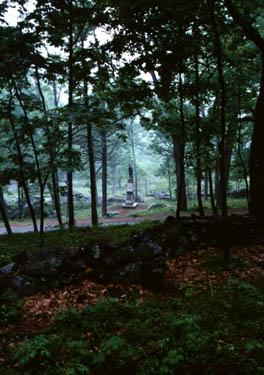
83rd Pennsylvania Monument,
looking from the 20th Maine's right flank,
Little Round Top, Gettysburg
National Military Park, PA.
Photo taken by
Margaret
Marley Stowell.
My friend Margaret and I visited
this spot during our 1998 trip to Gettysburg; it was a wet day, and
rather spooky, with all the fog and such around. She took a beautiful
picture! That's Colonel Strong Vincent 's statue atop this monument,
by the way.
On the way up the slope, the three Chamberlain brothers--Joshua,
John and Tom--were riding abreast of each other, when a solid shot
from a Confederate battery came flying into their midst. That
disturbed Colonel Chamberlain. He said to his brothers:
"Boys, I don't like this.
Another such shot might make it hard for mother. Tom, go to the rear
of the regiment and see that it is well closed up! John, pass up
ahead and look out a place for our
wounded."(9)
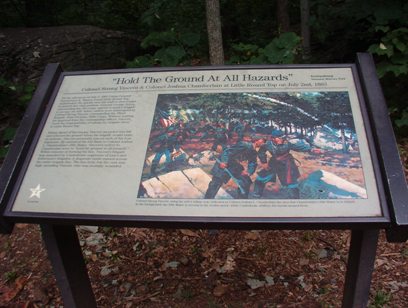
This is one of those National
Park Service battlefield markers at Gettysburg, depicting the monent
Colonel Strong Vincent tells Chamberlain to "Hold This Ground at All
Hazards".
Little Round Top, Gettysburg
National Military Park, Gettysburg, PA.
Photo courtesy of
Beth
Miller. Do
not use without her express written
permission.
From right to left, Vincent placed the men: 16th Michigan, 44th
New York, 83rd Pennsylvania--and the 20th Maine. The 20th Maine was
the last in line--the left flank of the entire Army of the Potomac!
Colonel Vincent wanted to make sure Chamberlain understood his
responsibility, and that of his men:
"Reaching the southern face
of Little Round Top, I found Vincent there, with intense poise and
look. He said with a voice of awe, as if translating the tables of
the eternal law, "I place you here! This is the left of the Union
line. You understand. You are to hold this ground at all
costs!'"(10)
Chamberlain definitely understood. He went about preparing his men
for what they would face. Years later, one of his officers, Captain
Howard Prince, would recall watching Chamberlain in the moments
before battle:
"Up and down the line, with
a last word of encouragement or caution, walks the quiet man, whose
calm exterior concealed the fire of the warrior and heart of steel,
whose careful dispositions and ready resource, whose unswerving
courage and audacious nerve in the last desperate crisis, are to
crown himself and his faithful soldiers with...fadeless
laurels."(11)
The Rebel shells stopped falling. That meant one thing: the
infantry was coming fast. Sure enough, it did, with the high-pitched
scream of the Rebel yell. They came storming up through the
trees--men of the 15th and 47th Alabama, and the 4th and 5th Texas,
of General John Bell Hood's brigade. Soon the 20th Maine was heavily
engaged:
"The edge of the conflict
swayed to and fro, with wild whirlpools and eddies. At times I saw
around me more of the enemy than of my own men; gaps opening,
swallowing, closing again with sharp convulsive energy...all around,
strange mingled roar..."(12)
One of Chamberlain's officers, a Lt. Nichols, ran up to him and
told him that something strange was going on in his front, behind the
Rebels engaging his men. The Confederates were trying to get around
the 20th's left flank. If they succeeded, the Rebels could get in the
brigade's rear, and destroy them piece by piece.
"That front had to be held,
and that rear covered...I called the captains and told them my
tactics: to keep the front fire at the hottest....and at the same
time, as they found opportunity, to take side-steps to the left,
coming gradually into one rank, file-closers and all. Then I took the
colors with their guard and placed them at our extreme left, where a
great boulder gave token and support; thence bending back at a right
angle the whole body gained ground leftward and made twice our
original front...This was a difficult movement to execute under such
fire, requiring coolness as well as heat. Of rare quality were my
officers and men."(13)
Chamberlain's daring maneuver--"refusing the line"--kept the left
flank from being overrun, but it thinned out his men, giving the
regiment no reserves.
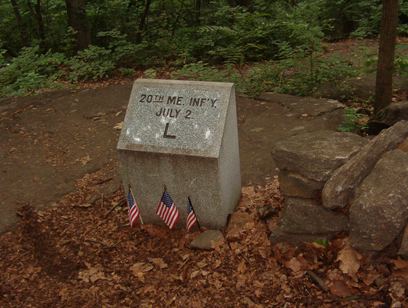
This marks the extreme left flank of
the 20th Maine's line, after Chamberlain had ordered them to 'refuse
the line'.
Little Round Top, Gettysburg National
Military Park, Gettysburg, PA.
Photo courtesy of
Beth
Miller.
Do not use without her express
written permission.
At one point in the battle, Chamberlain's life was in mortal
danger, although he didn't know it at the time. A Rebel sharpshooter
had him dead in his sights, but for some reason, could not bring
himself to pull the trigger. The unnamed man sent Chamberlain the
following letter some years after the war:
"Dear Sir: I want to tell
you of a little passage in the battle of Round Top, Gettysburg,
concerning you and me, which I am now glad of. Twice in that fight I
had your life in my hands. I got a safe place between two rocks, and
drew bead fair and square on you. You were standing in the open
behind the center of your line, full exposed. I knew your rank by
your uniform and your actions, and I thought it a mighty good thing
to put you out of the way. I rested my gun on the rock and took
steady aim. I started to pull the trigger, but some queer notion
stopped me. Then I got ashamed of my weakness and went through the
same motions again. I had you, perfectly certain. But this same queer
something shut right down on me. I couldn't pull the trigger, and
gave it up--that is, your life. I am glad of it now, and hope you
are. Yours truly, a member of the 15th
Alabama."(14)
I've always wondered what Chamberlain's immediate reaction to that
letter must have been! He mused:
"I thought
he was that, and answered him accordingly, asking him to come up
north and see whether I was worth what he missed. But my answer never
found him, nor could I afterwards."(15)
By this time, about two hours or so had passed, and the situation
for the 20th Maine was becoming desperate. Even though Chamberlain
had "refused the line", his left flank was taking a real beating, and
time was running out, as well as ammunition. As his men fired their
last rounds, they all looked at Chamberlain as if to say: "What now?"
Desperate times call for desperate measures, as they say. Let
Chamberlain describe what happened next:
"...Brave, warm-hearted Lt.
Melcher of the color company...came up and asked if he might take his
company and go forward and pick up one or two of his men left wounded
on the field...I answered, 'Yes, sir, in a moment! I am about to
order a charge!' Desperate as the chances were, there was nothing for
it, but to take the offensive. I stepped to the colors. The men
turned towards me. One word was enough-"BAYONET!"--it caught
like fire, and swept along the ranks. The men took it up with a
shout....it was vain to order
'FORWARD'".(16)
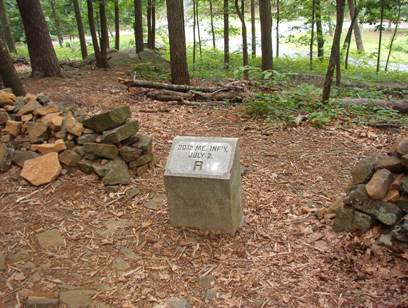
Here is the 20th Maine's right flank
marker.
Little Round Top, Gettysburg National
Military Park, Gettysburg, PA.
Photo courtesy of
Beth
Miller. Do not use
without her express written permission
The remaining 200 or so men of the regiment ran down the hill (as
much as the rocky terrain would let them), screaming hoarsely,
bayonets at the ready. The shocked Confederates didn't know what to
do; here were these bayonet-wielding Yankees bearing down on
them--when suddenly they were hit from the flank by musket fire! The
20th's Company B, led by Captain Walter Morrill, had been sent out on
the extreme left, as protection. They found a stone wall to hide
behind, and were joined by some U.S. Sharpshooters, who had been
driven off Big Round Top by the Confederates. This was all too much
for the exhausted Rebs; many threw down their weapons and
surrendered, and others ran, in the words of Colonel William Oates of
the 15th Alabama:
"...like a herd of wild
cattle".(17)
Chamberlain himself had another close call, almost at point-blank
range. A Confederate officer with a sword in one hand and big navy
revolver in the other, fired at Chamberlain's face. But the gun
misfired, and Chamberlain brought the point of his sword to the
officer's throat and took him prisoner. He took the officer's
revolver, and gave the sword and the officer into the hands of a
nearby sergeant.
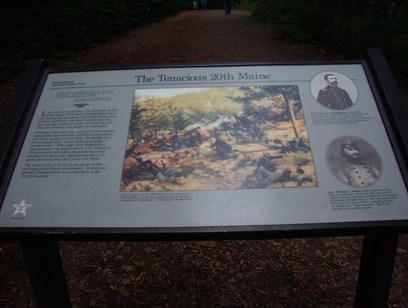
The Tenacious 20th Maine": a National
Park Service battlefield marker, describing what the regiment did on
that hot July 2, 1863.
Little Round Top, Gettysburg National
Military Park, Gettysburg, PA.
Photo courtesy of
Beth
Miller. Do not use
without her express written permission.
The 20th Maine, once it got started charging, was hard to stop.
They got as far as the front of the 44th New York, declaring they
were "on the road to Richmond"! It took Chamberlain and his officers
a while to bring the men back. They took, all told, around 400 Rebel
prisoners. In spite of their heroic charge, the day was not over for
the 20th Maine.
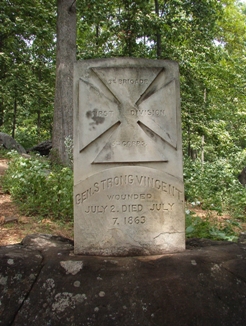
This monument marks the spot where
Colonel Strong Vincent, commander of the Third Brigade, First
Division, Fifth Corps, was mortally wounded, trying to rally the 16th
Michigan, on July 2, 1863.
He was promoted to Brigadier General
for his heroic action, but died of his wounds on July 7,
1863.
Little Round Top, Gettysburg National
Military Park, Gettysburg, PA.
Photo courtesy of
Beth
Miller. Do not use
without her express written permission.
The new Third Brigade commander, Colonel James Rice of the 44th
New York (Rice took over the Brigade's command after Strong Vincent
was mortally wounded earlier in the fight; Vincent had gone to shore
up the 16th Michigan's crumbling flank, when he was wounded in the
groin. He would die five days later of that wound.), ordered the 20th
Maine to take nearby Big Round Top, after a brigade of Pennsylvania
Reserves had refused to do so. Chamberlain then asked for volunteers,
and the whole exhausted regiment got up and followed him up the hill.
After a very nerve-racking ascent (they could take fire, but not
return it, much to their annoyance--plus they didn't know how many
Rebs were about!), the 20th Maine set up a watch and slept on their
arms. Eventually, they were supported by both the 44th New York and
83rd Pennsylvania--plus some of those Pennsylvania Reserves. They
also managed to take a few more Reb prisoners, mainly Texans from
Hood's Brigade.
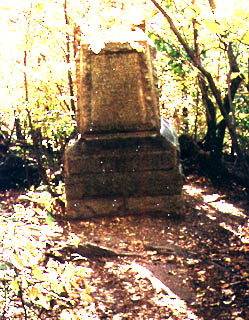
The "second" 20th Maine monument,
Big Round Top, Gettysburg
National Military Park, Gettysburg, PA.
This is a 20th Maine monument
that not many people see--because it's at the end of a long hard
climb up Big Round Top! I don't know HOW I made it up here! This
marks their position on the night of July 2-3, 1863. Too bad the
inscription's not easy to read.
After an anxious night, the 20th Maine was relieved on Big Round
Top, and placed in reserve near the Fifth Corps' headquarters. They
lay there during the bombardment that preceded "Pickett's Charge" on
July 3rd, but were too far away to be engaged in the fight on
Cemetery Ridge. They were also sent on a patrol near the Round Tops a
couple of days later, and saw some pretty ghastly scenes--one of
which was the remains of the John Sherfy barn, which had caught fire
during the battle. Inside had been wounded men from both sides, and,
being unable to escape, they burned to death. After what the 20th
Maine had gone through on July 2nd, this was almost too much to
bear...
Before leaving Gettysburg, the 20th Maine bid farewell to their
dead. They buried them in shallow graves, near where they fought and
died:
"There they lay, side by
side, with touch of elbow still; brave, manly resolution, heroic
self-giving, divine reconciliation...we buried them there, in a
grave, alas, too wide, on the sunny side of a great rock, eternal
witnesses of their worth--the rock and the sun. Rude head-boards,
made of ammunition boxes, rudely carved under tear-dimmed eyes,
marked and named each grave, and told each
home."(18)
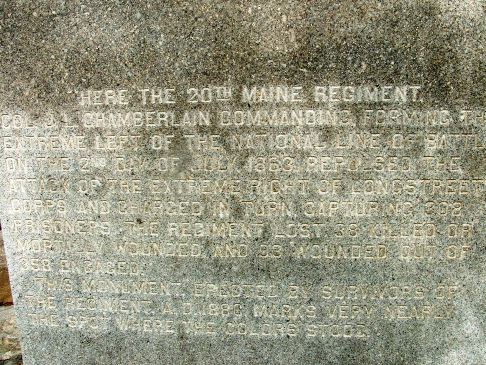
This is the inscription on the east
side of the 20th Maine monument,
Little Round Top, Gettysburg National
Military Park, Gettysburg, PA.
Photo by David
Valencia.
Do not use without his express written
permission.
It reads:
HERE THE 20TH MAINE REGIMENT
COL. J.L CHAMBERLAIN COMMANDING, FORMING THE EXTREME LEFT
OF THE NATIONAL LINE OF BATTLE ON THE 2nd DAY OF JULY 1863, REPULSED
THE ATTACK OF THE EXTREME RIGHT OF LONGSTREET'S CORPS AND CHARGED IN
TURN, CAPTURING 308 PRISONERS. THE REGIMENT LOST 38 KILLED OR
MORTALLY WOUNDED AND 93 WOUNDED OUT OF 358
ENGAGED.
THIS MONUMENT, ERECTED BY SURVIVORS OF
THE REGIMENT, A.D 1886, MARKS VERY NEARLY THE SPOT WHERE THE COLORS
STOOD.
NOTE:
This Web site is Copyright © 1999- 2009 Pat Finnegan.
All rights reserved.
DO NOT use any written
material, or photographs, without first contacting me in writing.
If you do not do this, be assured that legal action will be taken.
THANK
YOU!
QUESTIONS? COMMENTS?
SEND ME AN EMAIL!
 RETURN
TO HOME PAGE
RETURN
TO HOME PAGE